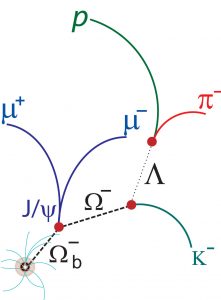Once produced, the decay of the Omega-sub-b (Ωb) proceeds like fireworks. The particle travels about a millimeter before it disintegrates into two intermediate particles called J/Psi (J/ψ) and Omega-minus (Ω-). The J/Psi then promptly decays into a pair of muons. The Omega-minus baryon, on the other hand, can travel several centimeters before decaying into yet another unstable particle called a Lambda (Λ) baryon along with a long-lived particle called kaon (K). The Lambda baryon, which has no electric charge, also can travel several centimeters prior to decaying into a proton (p) and a pion (π). (Credit: DZero collaboration)

